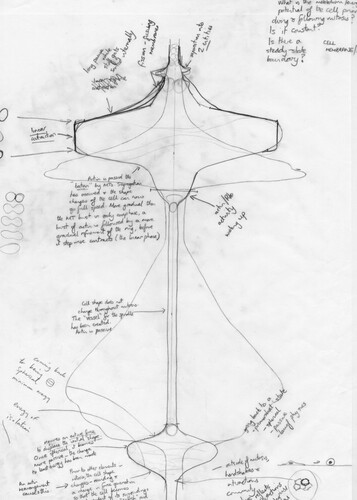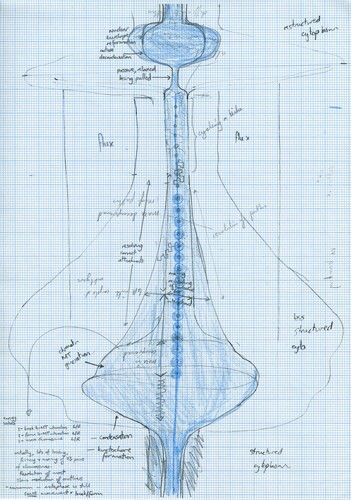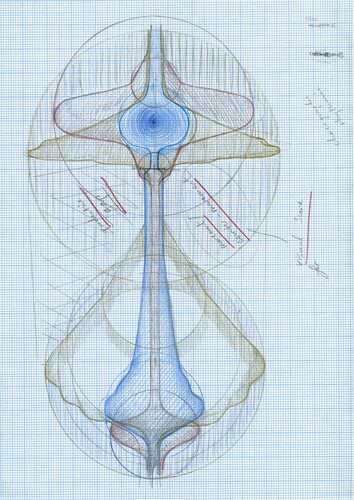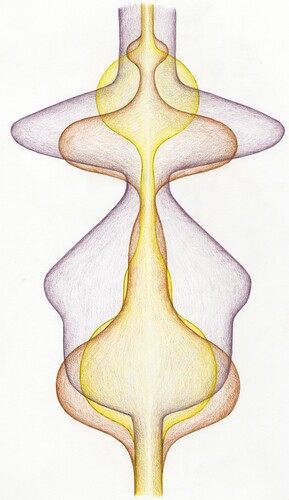ABSTRACT
Artist researcher Anderson shares a series of drawings developed through the experimental interdisciplinary project ‘Representing Biology as Process’. In this project Anderson and collaborators have developed a new approach to depict natural history through ‘relational process drawing’. With focus on the dynamic patterns of the processes of life and guided by principles of choreography, they draw together relationships between energy, time, movement, and environment at the molecular, cellular, and organismal scale. The drawings discussed are a kind of hybrid representation – composed to varying degrees of visual, numerical and linguistic expressions – that both provide new insights and generate new questions for future research.
I leave to several futures, (not to all), my garden of forking paths. (Luis Borges Citation1998)
Within the project, a key aspect is collaborative drawings with scientists. Through ‘relational process drawings’ we have developed a new approach to depict natural history. Rather than focusing on the morphology of the object, our drawings focus on the dynamic patterns of the processes of life and draw together relationships between energy, time, movement, and environment at the molecular, cellular, and organismal scale.
The process of mitosis (cell division) – drawn here in collaboration with biologist James Wakefield – is co-dependent and nested to other processes: protein folding is essential to cell division, which is essential to the development of the embryo (embryogenesis). Each process is intrinsically and reciprocally related to many others. The artistic view of this delicate, beyond visible, dynamic procedure allows us to explore the entire process of cell division in one connected image and to think of it in unconventional terms – as a dance, a score, an energetic form.
Although they are not realistic depictions, as ‘diagrams’ the mitosis score images can and often do show real properties of the biological process under investigation (cell division). The drawings with notations (1–2) are a kind of hybrid representation – they are composed to varying degrees of visual, numerical and linguistic expressions. Whereas the later drawings are only composed of visual representations, (3–4) as we no longer needed to write to clarify what we were doing, the process of drawing itself clarified the image that we held in our minds.
In the notational drawings (1–2) we guide what the viewer sees by using explanatory symbols, linguistic expressions, numerical values and colouring certain regions, so they also act as a description of the image. With choreographic principles and musical analogies as a guide, the annotations refer to the spatiotemporal interactions between DNA and microtubules during cell division that can be imagined as a ‘dance’.
Musical analogies have figured in several attempts to rethink biological ideas, such as the genome as a jazz score, or more general metaphors of life as music (Porta Citation2003; Noble Citation2008). If we consider the understanding of biological process to be about the spatial and temporal relationships of elements that result in the emergence of phenomena, then choreography as an organisational practice seems suitable as an approach. Both choreography and music are movement practices within a temporal framework that instrumentalize different bodies, i.e. the instrument of choreography is generally the human body, the instrument of music is generally the assemblage of musical instrument and human body, and the instruments of mitosis are the bodies of DNA, microtubules and the cell cortex.
In the ‘Garden of forking paths: Mitosis Score’ series we explored how drawing together with choreographic concepts can illuminate and expand ways of thinking about biological motion. Our reflections on the drawings not only suggested analogies with other life processes but also brought to the fore a number of questions relating to the process of cell division. For example, what sub-cellular activities outside of microtubules, DNA and the cell cortex are not represented by the current score? How could the shape change when other elements, such as the endomembrane system, are incorporated? Does the narrowing of the shape during metaphase simply reflect missing activities, such as the microtubule poleward flux? Or does the cell's energetic input into mitosis changes over time? If so, how close is the relationship between microtubule dynamics and mitochondria – the energy providers of the cell? These questions are new to the scientist involved in this project, even after 20 years of research and, as such, they provide a rich source of ideas for potential future experiments.
The title of the series is inspired by a short story by Luis Borges (Citation1998) ‘The garden of forking paths’. The idea of several possible futures and of a labyrinth of symbols all align with how we imagine cell division taking many possible paths in the abstract maze-like landscape of development.
The garden of forking paths is an incomplete, but not false, image of the universe […] an infinite series of times, a growing, dizzying web of divergent, convergent and parallel times. That fabric of times that approach one another, fork, are snipped off, or are simply unknown for centuries, contains all possibilities. (Luis Borges Citation1998, 85)
Figure 1. Gemma Anderson and James Wakefield, ‘Garden of forking paths; Mitosis Score (working drawing 1)’, 2019. Pencil, and colour pencil on paper, 29.7 × 42 cm.

Figure 2. Gemma Anderson and James Wakefield, ‘Garden of forking paths; Mitosis Score (working drawing 2)’, 2019. Pencil, and colour pencil on paper, 29.7 × 42 cm.

Disclosure statement
No potential conflict of interest was reported by the authors.
Additional information
Funding
Notes on contributors
Gemma Anderson
Gemma Anderson is an artist/researcher and mother of Una and Cosmo. She is currently co-investigator on the art/science/philosophy AHRC funded project ‘Representing Biology as Process’ (2017–2021) at the University of Exeter. She has collaborated on a number of interdisciplinary projects including ‘Hidden Geometries’ with the Mathematics Department at Imperial College London; ‘Isomorphology’ with the Natural History Museum, London; the ‘Cornwall Morphology and Drawing Centre’ at CAST, Cornwall; and ‘Portraits: Patients and Psychiatrists’ in collaboration with psychiatrists and patients at Bethlem Royal Hospital. Her work has been exhibited at the Victoria and Albert Museum, the Freud Museum and the Wellcome Collection, London. Most recently, her work is part of the exhibition ‘Critical Zones; Observatories for Earthly Politics’ at the Centre for Art and Media (ZKM), Karlsruhe, Germany and ‘The Botanical Mind: Art, Mysticism and the Cosmic Tree’ Exhibition at Camden Arts Centre, London. Recent publications include her book Drawing as a Way of Knowing in Art and Science (Intellect Press, 2017), and the peer reviewed articles ‘Drawing and the Dynamic Nature of Living Systems’, eLife Journal; ‘Dynamic Form: Klee as Artist and Morphologist’, Antennae Journal of Nature in Visual Culture; ‘On Drawing and Mathematics: From Inverse Vision to the Liberation of Form’, Leonardo Journal, and ‘Drawing Resemblance and Isomorphology’, Architectural Theory Review. Alongside academic publications, Anderson has produced limited edition Artist's Books including ‘Portraits: Patients and Psychiatrists’, Wellcome Trust, London, and ‘Isomorphology’ with Super-Collider, London and Atlantic Press, Cornwall.
Notes
1 Thanks to James Wakefield (Cell Biologist) and John Dupré (Philosopher of Biology) at the University of Exeter for their collaboration on this work and to the Arts and Humanities Research Council for funding ‘Representing Biology as Process’, project AH/P007457/1.
References
- Borges, Luis. 1998. Short Stories. London: Penguin.
- Porta, M. 2003. “The Genome Sequence Is a Jazz Score.” International Journal of Epidemiology 32: 29–31.
- Noble, D. 2008. The Music of Life: Biology Beyond Genes. Oxford: Oxford University Press.


